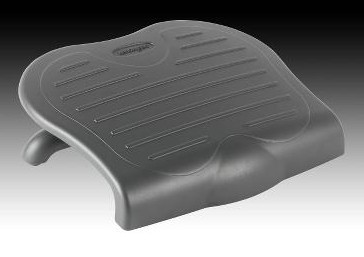Footrests

Why Use a Footrest
Footrests are generally recommended when a work surface cannot be adjusted to the proper height. This resutts in the chair being raised to the point that feet are not firmly plated on the ground and/or the pendulous leg creating excessive pressure at the back of the knee.
Footrests are a low cost workstation modification. They are especially appropriate when an esentially static workstation is being shared by persons of different builds. One person may use the footrest while another may not. Often this is enough to make the workstation a close fit for most people.
Stability vs Mobility
There is an ongoing discussion among Ergonomists about how to put more mobility into the office workplace. The value of this is essentially to decrease the number of static positions people adopt and the length of time they spend in them. We know from research that movement is better.
In an attempt to increase movement in the workstation, inventors have recently begun to market more moveable footrests. While this initially seems a great idea, consider for a moment how people sit. If they cannot reach the floor solidly, they are soon bringing their feet back and placing them on the caster heads or wrapping their legs closly around the seat pan. The actions help to regain a stable bse of support.
Most people who work at a desk require a moderate to active mobility in their trunk and upper limbs. In order for this to be attained while maintaining overall postural balance, the base of posture (sacral and hip area) must be stable. This stabilization comes through the tripod of Right and Left feet and sacrum at the back of the chair. Some people circumvent this by drawing both legs up and creating stability on top of the chair seat pan.
The purpose of a footrest is to allow stability when it is otherwise not attainable in a good biomechanical and physiological manner. It brings the floor up to the level of the feet. It needs to be stable.
Flat vs Angled Footrests
Sitting bolt1upright in a chair with the knees bend to 90° and feet flat on the floor is not very comfortable. In fact, people seldom do it for any period of time. It is more common to have the legs slightly more open than 90° up to perhaps 120°.

In order to do this and maintain support, a little less chair height (or more footrest height) is required. Exactly how much more or less is a qeustion. For that reason, many footrests are angled and can easily adapt to a range of heights. Generally the more basic the better.
Another thing to keep in mind is that the further you are from a 90° knee, the less flat your feet are on the floor. For a good base of support, the angle of the footrest top should match the angle of your feet.
Footrest Efficacy
A workstation that requires a footrest will seldom be as good as a workstation that fits without such modification. Most jobs require movment between desk surfaces. Each move increases the potential for compromise. Employees will generally leave the footrest in one spot rather than moving it from place to place. And having more than one footrest at a workstation is irritating. They tend to get in the way of free movement around the workstation.
In shared worstations, the employee who does not need the footrest will often move it out of the way – often way back under the desk. In order for the next employee to use it, they must get down on the floor and crawl a bit in order to retrieve it. The situation is a trip hazard for the employee who doesn't need the footrest and a potential back or knee injury for the one that does. The risk is not high. It's more likely that the footrest won't be routinely used.
The UpShot?
- BEST— Individually adjusted workstations
- Second Best— Provide a simple low angled - wedge shaped footrest and an accessible place to put it at end of shift
| Footrests for Three Different Uses | ||
|---|---|---|
| Travel | Industrial | Office |
This site needs an editor - click to learn more!

Related Articles
Editor's Picks Articles
Top Ten Articles
Previous Features
Site Map
Content copyright © 2023 by virginia hixson. All rights reserved.
This content was written by virginia hixson. If you wish to use this content in any manner, you need written permission. Contact
BellaOnline Administration
for details.


